Education & Activity
Education
What is Mangrove?
Mangroves are coastal forest ecosystems that grow in tidal areas, especially in tropical and subtropical areas such as river estuaries and protected beaches. Mangrove plants have the unique ability to live in environments with high salt content and muddy soil with minimal oxygen, thanks to special roots such as pencil roots/breathing roots, prop roots, knee roots, board roots, air roots, banir roots, without air roots. This ecosystem plays an important role in maintaining environmental balance, such as preventing coastal abrasion, dampening waves, becoming a habitat for various types of animals, and absorbing carbon dioxide from the atmosphere. In addition, mangroves also provide economic benefits to coastal communities, especially in the fields of fisheries and ecotourism. Because of their important role, mangroves need to be protected and preserved from the threat of damage due to human activities and climate change.
Mangroves: Earth’s Carbon Guardians
Mangroves are exceptional carbon absorbers, storing up to 4 times more carbon than typical tropical forests. Their secret lies in dense planting and unique root systems like pneumatophores, prop roots, and pencil roots. These roots not only support the trees but also trap mud, where 60–70% of carbon remains safely stored for centuries. The rest is kept in the trunks and leaves, offering double protection for our planet against climate change.
Mangroves: Nature’s Gift to Coastal Communities
1. Economic Lifeline
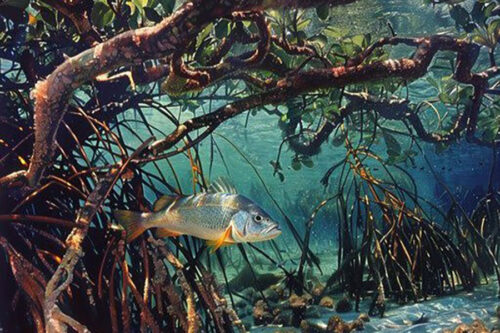
Mangroves are more than trees they are a source of food, income, and security for coastal communities. From fishing and crab farming to eco-friendly crafts like mangrove syrup and batik dyes, they sustain livelihoods while protecting shorelines from costly damage.
2. A Destination for Discovery
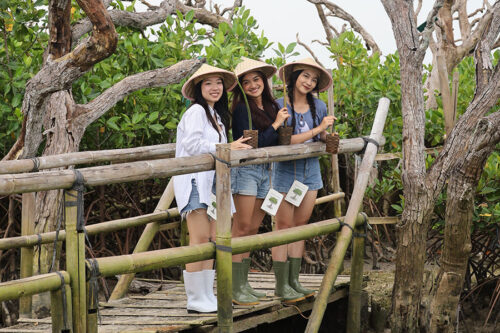
Explore winding boardwalks, glide through tranquil rivers, or watch rare birds among the roots. Mangrove ecotourism sparks wonder while creating jobs for local guides, boat operators, and small businesses.
3. Guardians of the Environment
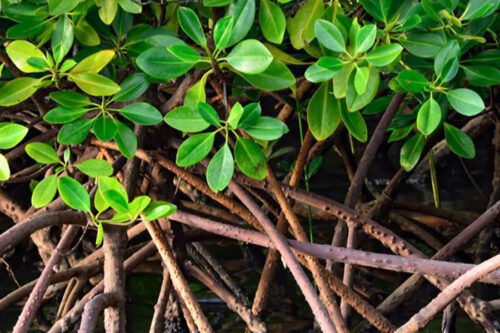
Mangroves capture and store massive amounts of carbon, filter waste before it reaches the sea, and provide safe habitats for fish, birds, and countless other species keeping our planet in balance.
4. Living Classrooms
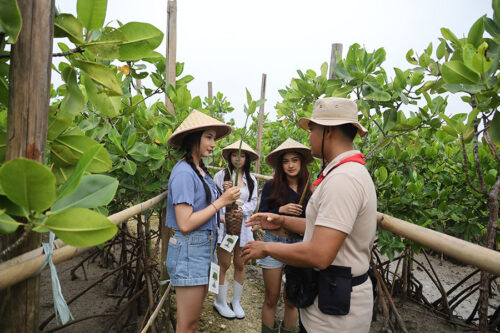
Mangrove forests are open-air classrooms and natural laboratories. They teach lessons on resilience, biodiversity, and climate change to students, researchers, and anyone willing to listen to nature’s wisdom.
Mangrove Forest Zoning & Its Types
- Front Zone This is the zone that faces the sea directly. Plants that make up the front zone can be seen from the shape of their roots, which are dominated by the shape of breathing roots/pencils. Plants that grow in the front zone can be classified into several types, such as Sonneratia spp and Avicennia spp.
- Middle Zone This is the zone in the middle/affected by the ebb and flow of sea water. Plants that make up the middle zone can be seen from the shape of their roots, where the roots are in the form of supporting roots. Plants that grow in the middle zone are dominated by the Rhizophora spp type.
- Back Zone This is the zone behind/rarely affected by the ebb and flow of sea water. Plants that grow in the back zone can be classified into several types, such as Bruguiera spp, Ceriop spp, Xylocarpus spp, and Pemphis acidula.
Why Mangrove Conservation?
Mangrove conservation is important because mangroves protect the coast from abrasion, flooding, and large waves such as tsunamis. Mangrove roots also help maintain water cleanliness and prevent pollution. In addition, mangroves are a habitat for many animals such as fish, crabs, and birds, which are beneficial to fishermen and surrounding communities. Mangroves also help absorb greenhouse gases and reduce the impact of climate change. If mangroves are damaged, the coastal environment can be more vulnerable and communities will lose many benefits. Therefore, mangroves need to be protected and preserved.
Mangrove Adoption Results
Mangrove planting activities have been successfully implemented by involving local communities to plant hundreds of seedlings in coastal areas to support environmental conservation.
Education
What is Mangrove?
Mangroves: Earth’s Carbon Guardians
Mangroves: Nature’s Gift to Coastal Communities
1. Economic Lifeline

Mangroves are more than trees they are a source of food, income, and security for coastal communities. From fishing and crab farming to eco-friendly crafts like mangrove syrup and batik dyes, they sustain livelihoods while protecting shorelines from costly damage.
2. A Destination for Discovery

Explore winding boardwalks, glide through tranquil rivers, or watch rare birds among the roots. Mangrove ecotourism sparks wonder while creating jobs for local guides, boat operators, and small businesses.
3. Guardians of the Environment

Mangroves capture and store massive amounts of carbon, filter waste before it reaches the sea, and provide safe habitats for fish, birds, and countless other species keeping our planet in balance.
4. Living Classrooms

Mangrove forests are open-air classrooms and natural laboratories. They teach lessons on resilience, biodiversity, and climate change to students, researchers, and anyone willing to listen to nature’s wisdom.
Mangrove Forest Zoning & Its Types
- Front Zone This is the zone that faces the sea directly. Plants that make up the front zone can be seen from the shape of their roots, which are dominated by the shape of breathing roots/pencils. Plants that grow in the front zone can be classified into several types, such as Sonneratia spp and Avicennia spp.
- Middle Zone This is the zone in the middle/affected by the ebb and flow of sea water. Plants that make up the middle zone can be seen from the shape of their roots, where the roots are in the form of supporting roots. Plants that grow in the middle zone are dominated by the Rhizophora spp type.
- Back Zone This is the zone behind/rarely affected by the ebb and flow of sea water. Plants that grow in the back zone can be classified into several types, such as Bruguiera spp, Ceriop spp, Xylocarpus spp, and Pemphis acidula.
Why Mangrove Conservation?
Mangrove Adoption Results
Education & Activity
Education
What is Mangrove?
Mangroves: Earth’s Carbon Guardians
Mangroves: Nature’s Gift to Coastal Communities
1. Economic Lifeline

Mangroves are more than trees they are a source of food, income, and security for coastal communities. From fishing and crab farming to eco-friendly crafts like mangrove syrup and batik dyes, they sustain livelihoods while protecting shorelines from costly damage.
2. A Destination for Discovery

Explore winding boardwalks, glide through tranquil rivers, or watch rare birds among the roots. Mangrove ecotourism sparks wonder while creating jobs for local guides, boat operators, and small businesses.
3. Guardians of the Environment

Mangroves capture and store massive amounts of carbon, filter waste before it reaches the sea, and provide safe habitats for fish, birds, and countless other species keeping our planet in balance.
4. Living Classrooms

Mangrove forests are open-air classrooms and natural laboratories. They teach lessons on resilience, biodiversity, and climate change to students, researchers, and anyone willing to listen to nature’s wisdom.
Mangrove Forest Zoning & Its Types
- Front Zone This is the zone that faces the sea directly. Plants that make up the front zone can be seen from the shape of their roots, which are dominated by the shape of breathing roots/pencils. Plants that grow in the front zone can be classified into several types, such as Sonneratia spp and Avicennia spp.
- Middle Zone This is the zone in the middle/affected by the ebb and flow of sea water. Plants that make up the middle zone can be seen from the shape of their roots, where the roots are in the form of supporting roots. Plants that grow in the middle zone are dominated by the Rhizophora spp type.
- Back Zone This is the zone behind/rarely affected by the ebb and flow of sea water. Plants that grow in the back zone can be classified into several types, such as Bruguiera spp, Ceriop spp, Xylocarpus spp, and Pemphis acidula.
Why Mangrove Conservation?
Mangrove Adoption Results
Education
What is Mangrove?
Mangroves are coastal forest ecosystems that grow in tidal areas, especially in tropical and subtropical areas such as river estuaries and protected beaches. Mangrove plants have the unique ability to live in environments with high salt content and muddy soil with minimal oxygen, thanks to special roots such as pencil roots/breathing roots, prop roots, knee roots, board roots, air roots, banir roots, without air roots. This ecosystem plays an important role in maintaining environmental balance, such as preventing coastal abrasion, dampening waves, becoming a habitat for various types of animals, and absorbing carbon dioxide from the atmosphere. In addition, mangroves also provide economic benefits to coastal communities, especially in the fields of fisheries and ecotourism. Because of their important role, mangroves need to be protected and preserved from the threat of damage due to human activities and climate change.
Mangroves: Earth’s Carbon Guardians
Mangroves are exceptional carbon absorbers, storing up to 4 times more carbon than typical tropical forests. Their secret lies in dense planting and unique root systems like pneumatophores, prop roots, and pencil roots. These roots not only support the trees but also trap mud, where 60–70% of carbon remains safely stored for centuries. The rest is kept in the trunks and leaves, offering double protection for our planet against climate change.
Mangroves: Nature’s Gift to Coastal Communities
1. Economic Lifeline

Mangroves are more than trees they are a source of food, income, and security for coastal communities. From fishing and crab farming to eco-friendly crafts like mangrove syrup and batik dyes, they sustain livelihoods while protecting shorelines from costly damage.
2. A Destination for Discovery

Explore winding boardwalks, glide through tranquil rivers, or watch rare birds among the roots. Mangrove ecotourism sparks wonder while creating jobs for local guides, boat operators, and small businesses.
3. Guardians of the Environment

Mangroves capture and store massive amounts of carbon, filter waste before it reaches the sea, and provide safe habitats for fish, birds, and countless other species keeping our planet in balance.
4. Living Classrooms

Mangrove forests are open-air classrooms and natural laboratories. They teach lessons on resilience, biodiversity, and climate change to students, researchers, and anyone willing to listen to nature’s wisdom.
Mangrove Forest Zoning & Its Types
- Front Zone This is the zone that faces the sea directly. Plants that make up the front zone can be seen from the shape of their roots, which are dominated by the shape of breathing roots/pencils. Plants that grow in the front zone can be classified into several types, such as Sonneratia spp and Avicennia spp.
- Middle Zone This is the zone in the middle/affected by the ebb and flow of sea water. Plants that make up the middle zone can be seen from the shape of their roots, where the roots are in the form of supporting roots. Plants that grow in the middle zone are dominated by the Rhizophora spp type.
- Back Zone This is the zone behind/rarely affected by the ebb and flow of sea water. Plants that grow in the back zone can be classified into several types, such as Bruguiera spp, Ceriop spp, Xylocarpus spp, and Pemphis acidula.
Why Mangrove Conservation?
Mangrove conservation is important because mangroves protect the coast from abrasion, flooding, and large waves such as tsunamis. Mangrove roots also help maintain water cleanliness and prevent pollution. In addition, mangroves are a habitat for many animals such as fish, crabs, and birds, which are beneficial to fishermen and surrounding communities. Mangroves also help absorb greenhouse gases and reduce the impact of climate change. If mangroves are damaged, the coastal environment can be more vulnerable and communities will lose many benefits. Therefore, mangroves need to be protected and preserved.
Mangrove Adoption Results
Mangrove planting activities have been successfully implemented by involving local communities to plant hundreds of seedlings in coastal areas to support environmental conservation.
Activity

THE ROOTS
Learn about coastal nature and adopt your own mangrove tree to be part of the nature loving community.
 Adult : IDR 400.000
Adult : IDR 400.000
 Child : IDR 350.000
Child : IDR 350.000
Include :
- Educational Tour
- Lead by Tour Leader
- One Baby Mangrove
- Full Mangrove Experience
- Towel & Shower Facility
- Welcome Drink
- Insurance
- Adventure Book
- Free All You Can Stamp
- Personalized Certificate

THE STEM
Exploring the unknown mangrove forest, guided by a tour leader who will explain the wonders of mangroves and you will be amazed.
 Adult : IDR 300.000
Adult : IDR 300.000
 Child : IDR 250.000
Child : IDR 250.000
Include :
- Educational Tour
- Lead by Tour Leader
- Full Mangrove Experience
- Towel & Shower Facility
- Welcome Drink
- Insurance
- Adventure Book
- Free All You Can Stamp
- Personalized Certificate
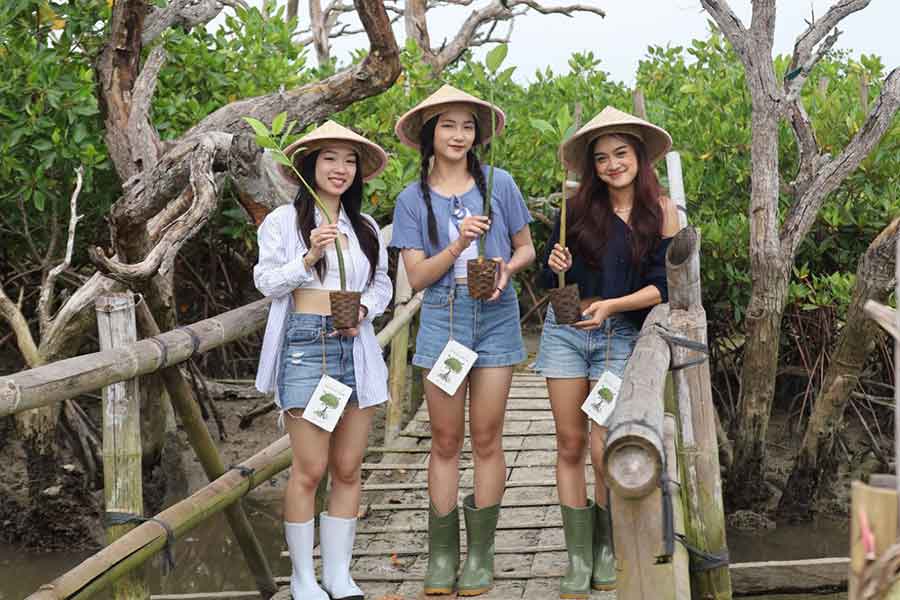
THE LEAF
A short escape from the modern world to learn about the beauty of mangroce nature in a relaxed and enjoyable way.
 Adult : IDR 250.000
Adult : IDR 250.000
 Child : IDR 200.000
Child : IDR 200.000
Include :
- Lead by tour leader
- Trekking & observation wildlife hunting
- Simple education tour
- Welcome drink
Activity

THE ROOTS
Learn about coastal nature and adopt your own mangrove tree to be part of the nature loving community.
 Adult : IDR 400.000
Adult : IDR 400.000
 Child : IDR 350.000
Child : IDR 350.000
Include :
- Educational Tour
- Lead by Tour Leader
- One Baby Mangrove
- Full Mangrove Experience
- Towel & Shower Facility
- Welcome Drink
- Insurance
- Adventure Book
- Free All You Can Stamp
- Personalized Certificate

THE STEM
Exploring the unknown mangrove forest, guided by a tour leader who will explain the wonders of mangroves and you will be amazed.
 Adult : IDR 300.000
Adult : IDR 300.000
 Child : IDR 250.000
Child : IDR 250.000
Include :
- Educational Tour
- Lead by Tour Leader
- Full Mangrove Experience
- Towel & Shower Facility
- Welcome Drink
- Insurance
- Adventure Book
- Free All You Can Stamp
- Personalized Certificate

THE LEAF
A short escape from the modern world to learn about the beauty of mangroce nature in a relaxed and enjoyable way.
 Adult : IDR 250.000
Adult : IDR 250.000
 Child : IDR 200.000
Child : IDR 200.000
Include :
- Lead by tour leader
- Trekking & observation wildlife hunting
- Simple education tour
- Welcome drink


